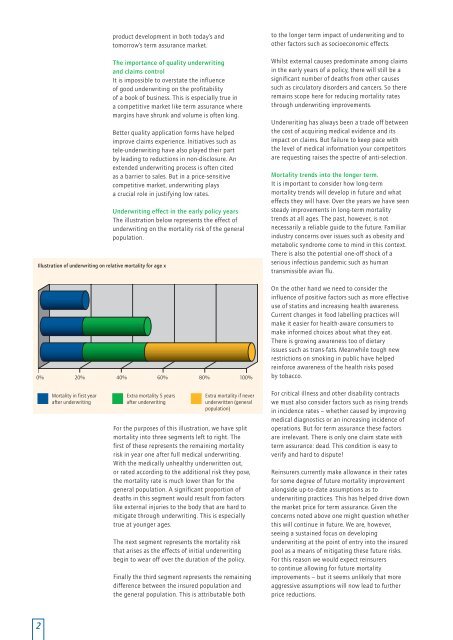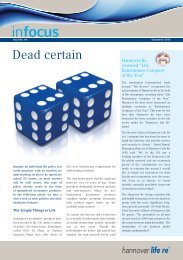Hannover 32:Hannover 28 - Hannover Re UK Life Branch
Hannover 32:Hannover 28 - Hannover Re UK Life Branch
Hannover 32:Hannover 28 - Hannover Re UK Life Branch
You also want an ePaper? Increase the reach of your titles
YUMPU automatically turns print PDFs into web optimized ePapers that Google loves.
Illustration of underwriting on relative mortality for age x<br />
product development in both today’s and<br />
tomorrow’s term assurance market.<br />
The importance of quality underwriting<br />
and claims control<br />
It is impossible to overstate the influence<br />
of good underwriting on the profitability<br />
of a book of business. This is especially true in<br />
a competitive market like term assurance where<br />
margins have shrunk and volume is often king.<br />
Better quality application forms have helped<br />
improve claims experience. Initiatives such as<br />
tele-underwriting have also played their part<br />
by leading to reductions in non-disclosure. An<br />
extended underwriting process is often cited<br />
as a barrier to sales. But in a price-sensitive<br />
competitive market, underwriting plays<br />
a crucial role in justifying low rates.<br />
Underwriting effect in the early policy years<br />
The illustration below represents the effect of<br />
underwriting on the mortality risk of the general<br />
population.<br />
0% 20% 40% 60% 80% 100%<br />
to the longer term impact of underwriting and to<br />
other factors such as socioeconomic effects.<br />
Whilst external causes predominate among claims<br />
in the early years of a policy, there will still be a<br />
significant number of deaths from other causes<br />
such as circulatory disorders and cancers. So there<br />
remains scope here for reducing mortality rates<br />
through underwriting improvements.<br />
Underwriting has always been a trade off between<br />
the cost of acquiring medical evidence and its<br />
impact on claims. But failure to keep pace with<br />
the level of medical information your competitors<br />
are requesting raises the spectre of anti-selection.<br />
Mortality trends into the longer term.<br />
It is important to consider how long-term<br />
mortality trends will develop in future and what<br />
effects they will have. Over the years we have seen<br />
steady improvements in long-term mortality<br />
trends at all ages. The past, however, is not<br />
necessarily a reliable guide to the future. Familiar<br />
industry concerns over issues such as obesity and<br />
metabolic syndrome come to mind in this context.<br />
There is also the potential one-off shock of a<br />
serious infectious pandemic such as human<br />
transmissible avian flu.<br />
On the other hand we need to consider the<br />
influence of positive factors such as more effective<br />
use of statins and increasing health awareness.<br />
Current changes in food labelling practices will<br />
make it easier for health-aware consumers to<br />
make informed choices about what they eat.<br />
There is growing awareness too of dietary<br />
issues such as trans-fats. Meanwhile tough new<br />
restrictions on smoking in public have helped<br />
reinforce awareness of the health risks posed<br />
by tobacco.<br />
Mortality in first year<br />
after underwriting<br />
Extra mortality 5 years<br />
after underwriting<br />
Extra mortality if never<br />
underwritten (general<br />
population)<br />
For the purposes of this illustration, we have split<br />
mortality into three segments left to right. The<br />
first of these represents the remaining mortality<br />
risk in year one after full medical underwriting.<br />
With the medically unhealthy underwritten out,<br />
or rated according to the additional risk they pose,<br />
the mortality rate is much lower than for the<br />
general population. A significant proportion of<br />
deaths in this segment would result from factors<br />
like external injuries to the body that are hard to<br />
mitigate through underwriting. This is especially<br />
true at younger ages.<br />
The next segment represents the mortality risk<br />
that arises as the effects of initial underwriting<br />
begin to wear off over the duration of the policy.<br />
Finally the third segment represents the remaining<br />
difference between the insured population and<br />
the general population. This is attributable both<br />
For critical illness and other disability contracts<br />
we must also consider factors such as rising trends<br />
in incidence rates – whether caused by improving<br />
medical diagnostics or an increasing incidence of<br />
operations. But for term assurance these factors<br />
are irrelevant. There is only one claim state with<br />
term assurance: dead. This condition is easy to<br />
verify and hard to dispute!<br />
<strong>Re</strong>insurers currently make allowance in their rates<br />
for some degree of future mortality improvement<br />
alongside up-to-date assumptions as to<br />
underwriting practices. This has helped drive down<br />
the market price for term assurance. Given the<br />
concerns noted above one might question whether<br />
this will continue in future. We are, however,<br />
seeing a sustained focus on developing<br />
underwriting at the point of entry into the insured<br />
pool as a means of mitigating these future risks.<br />
For this reason we would expect reinsurers<br />
to continue allowing for future mortality<br />
improvements – but it seems unlikely that more<br />
aggressive assumptions will now lead to further<br />
price reductions.<br />
2





